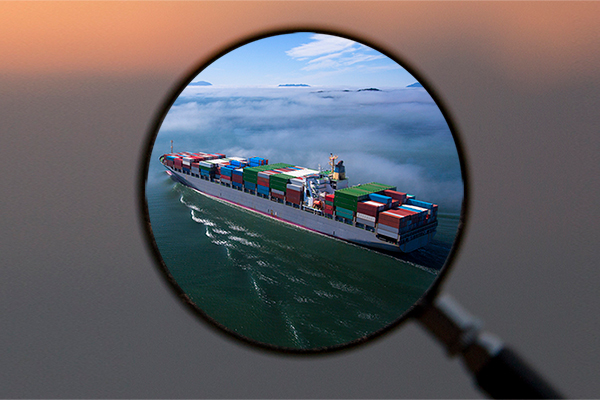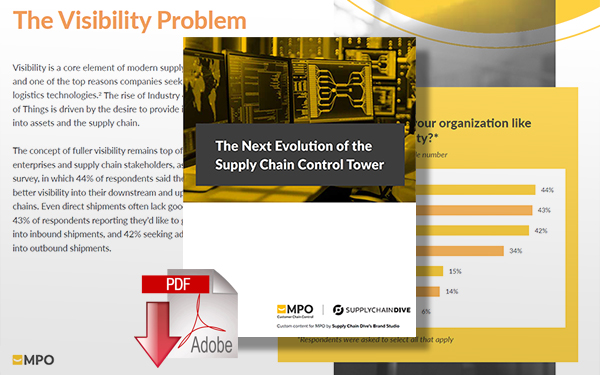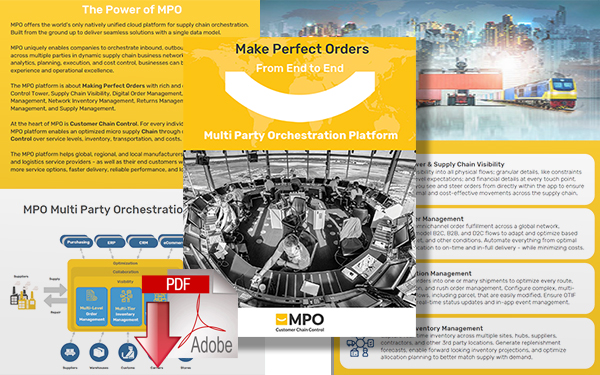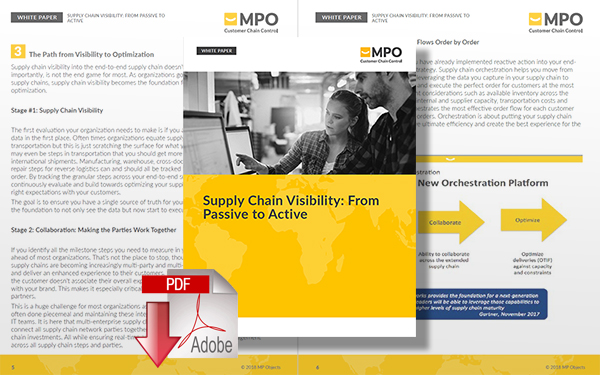Why a Lack of Supply Chain Visibility is Costing Your Business

Today, visibility is not just a convenient systems upgrade, it’s part of a greater movement to adopt a more unified perspective of the supply chain, however, despite growing complexity, there’s still a lack of end-to-end visibility.
Lack of Visibility Is Costing Your Business
Supply chain visibility has always been important.
Despite growing complexity, there’s still a lack of end-to-end supply chain visibility.
About half of all organizations don’t really know what’s happening at key integration points across their business transactions.
And, with so many service levels, requirements, constraints, and disruptions, it’s become a gargantuan task to keep track of all the moving parts and how they affect outcomes.
In the video to the right, we describe how unifying supply chain cloud platforms are helping businesses get the speed and agility they need to stay resilient and lower costs.
So, what’s suddenly motivating companies to prioritize this capability?
Today’s Supply Chain Complexity Creates Many Blind Spots
There was a time when an analytics dashboard would have sufficed to secure a centralized view of your data, as well as set and report on some KPIs. Today, such a system barely scrapes the surface of what businesses need to prosperously run complex, global supply chains and deliver exceptional customer service.
International operations are exposed to environmental and political change, and therefore a lot more uncertainty than small, locally run businesses. As businesses expand globally, they also become multi-modal. Not all technology supports every mode, leaving companies to struggle with limited visibility – or else several siloed solutions – as they scale. This goes tenfold for logistics service providers who manage a substantial number of varying supply chains for their customers.
Multi-enterprise business networks also contribute to today’s supply chain complexity, as organizations are building and leveraging partnerships with everyone from manufacturers and distributors to logistics service providers. Moreover, each set of business processes doesn’t exist in a vacuum but is part of a greater ecosystem. Lacking one version of the truth, as well as contextual insight into how upstream and downstream flows affect one another negatively impacts efficiency, profitability, and a company’s ability to effectively optimize operations as a whole.
Read: What Is The Multi-Multi Problem Costing Your Business?
The advent of e-commerce further pressures businesses to leverage these partnerships with dynamism and intelligent flexibility through complex models of fulfillment. Without proper visibility, it becomes next to impossible to optimally choose between multiple sources, delivery points, and logistical processes to consistently ensure profitability and customer satisfaction.
Old Architectures and Incremental Upgrades Don’t Do Enough to Purge the Blind Spots
Some businesses may have put visibility low on the list because they felt their company was running well enough and preferred to deal with more ‘pressing’ and imminent problems. Those who did see supply chain visibility as a concern tended to address the matter through incremental upgrades. Rather than treat the supply chain as a large, complex ecosystem, it’s been common practice to address pain points within sectors and maximize the functionality of each separate branch, focusing on the manufacturing or warehousing sector or investing in a logistics control tower for greater transport visibility.
It took a while for supply chain visibility to gain extraordinary momentum. This has much to do with practitioners realizing the crucial role this capability plays in such ‘pressing and imminent’ problems as cost control and boosting customer satisfaction. Mainly because most issues – poor inventory management, ineffective communication, exorbitant errors, and delays – either boil down to a lack of visibility or else cannot be resolved without first implementing a proper supply chain visibility solution. Visibility is a necessary foundation to all other supply chain functions.
That brings us to our second problem: old architectures and incremental upgrades. Because visibility was long seen as a modifier to more fundamental systems (WMS, TMS, etc.), supply chain visibility has also been implemented in silos, modifying the system it was purchased for. This is why ‘end-to-end’ visibility, specifically, has ascended in the ranks to become one of the most sought-after solutions. At best, a visibility solution will span the end-to-end logistical supply chain but won’t do much to provide context into sourcing or reverse flows, for example.
Transitioning to a Multi-Enterprise Orchestration Platform
Businesses are realizing that supply chain visibility needs to extend beyond discrete functions and logistical concerns (i.e. the location of a shipment, exceptions alerts, compliance). Because, in addition to delivering on time and in full (OTIF), businesses must do so profitably. That means taking a holistic and unified view of the supply chain to understand how previously isolated functions and processes affect one another.
The multi-enterprise orchestration platform is a holistic technology that unifies the disparate sectors of the supply chain. It enables businesses to “orchestrate” fulfillment across their end-to-end network rather than manage the various process and sectors in isolation.
Treating the network as a multi-party ecosystem offers extraordinary opportunities for improving service while controlling costs. With insight into the greater ecosystem, businesses gain contextual insight into how all processes and flows impact each other. Optimization and cost considerations begin at the level of sourcing rather than shipping and span all modes, as well as interplant, returns, repairs, and rebalance flows. Holistic supply chain visibility, therefore, allows businesses to dynamically source inventory, converge flows, and make highly informed and strategic decisions that positively affect all processes and partnerships.
Today, visibility is not just a convenient systems upgrade – it’s part of a greater movement to adopt a more unified perspective of the supply chain and begin treating it as the complex ecosystem it has become.
For unparalleled end-to-end supply chain visibility, MPO offers the world’s only Control Tower for Orchestration on a single, unified cloud platform. Businesses operating in a range of industries can leverage this powerful solution to gain transparency across the entire multi-party network and optimize their complex, global supply chains to reach unprecedented levels of efficiency, customer service, and cost savings. You can learn more about how it will serve your business by requesting a demo or downloading our free white papers today!
Looking for a robust end-to-end supply chain visibility solution? Supply Chain Visibility has significantly evolved from a buzzword in logistics circles that referred to track and trace capabilities to a more holistic solution that extends beyond transportation to cover all order flows and inventory across both in-house and third-party locations. Growing customer demands, supply chain complexity, and business networks are redefining what it takes to optimize supply chain management and consistently achieve high standards amid disruption and uncertainty. Download the guide below to learn more about what a next-gen supply chain visibility solution is capable of.
You can also get in touch by reaching out to [email protected], [email protected], or requesting a demo today.
Related Resources
The Next Evolution of the Supply Chain Control Tower
This white paper explores why visibility is a core element of modern supply chain digitization, and a top reason to implement logistics technologies in your supply chain. Download Now!
Multi-Party Orchestration Platform
In this brochure, you'll find a guide to MPO's unified cloud platform for multi-party orchestration, including its rich and flexible solutions: Control Tower, Supply Chain Visibility, Digital Order Management, Transportation Management, Network Inventory Management, Returns Management, Spare Parts Management, and Supply Management. Download Now!
Supply Chain Visibility: From Passive to Active
This whitepaper answers the questions: “What is Supply Chain Visibility - and why is it important?” Download Now!
More Resources from MPO
Related Article: Avoiding Hurdles When Making the Leap to Implementing Supply Chain Visibility
Article Topics
MPO News & Resources
TMS+ Go Beyond Transport to Optimize Cost, Service, & Resiliency Multi-Party Orchestration Platform When It Comes to Digital Transformation You May Not Be Doing What You Think How Chief Operating Officers are Achieving Results with Supply Chain Software SPARK Matrix Transportation Management System Software Analyst Report Top Trends Driving Change and Technology Strategy Within Logistics & Transportation Management 5 Key Steps for Optimizing your Last Mile Delivery More MPOLatest in Supply Chain
FedEx Announces Plans to Shut Down Four Facilities How Supply Chains Are Solving Severe Workplace Shortages SAP Unveils New AI-Driven Supply Chain Innovations How Much Extra Will Consumers Pay for Sustainable Packaging? U.S. Manufacturing is Growing but Employment Not Keeping Pace The Two Most Important Factors in Last-Mile Delivery Most Companies Unprepared For Supply Chain Emergency More Supply Chain

















